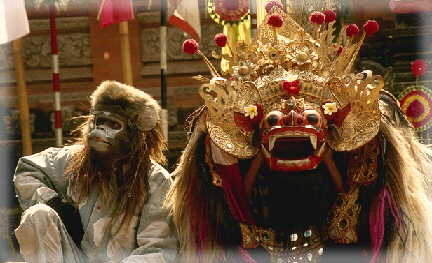Bali and Tourism
Ending the prehistoric era, Bali had intended to do a search and travel by spiritual aspirants. Markandeya recorded as a spiritual figure of Java first set down a trip in Bali. The journey to search inward purity and natural balance and then put milestone Hindu religious order on the southern slope of Mount Agung is now known as the Pura Agung Besakih. Pura Basukian believed to be the first milestone with his followers ensure Markandeya Bali as a land of spiritual goal of building value.
Like continuous, simultaneous order of spiritual life coincided with governance in Bali. Warmadewa Dynasty rule mentioned in various ancient texts strongly supports the survival of religion with culture and local customs that invite the arrival of spiritual figures and Java. Sektar professor Kuturan arrival at the 11th century is certainly capable of pasting the way of life of local communities by order of Hinduism brought from Java. Order the traditional village with parhyangan concept as the personification of God in the functioning of Tri Murti is an effort to accommodate the unification of the concept of local Hindu concepts.
The spiritual journey continues conducted by prominent Hindu Religion of Java. The unification of the archipelago by Majapahit was the highlight of the journey and transformation of religion and local culture with Hindu culture. In the course of time, Bali and its people then live their daily lives with the order of life, religion, art, and unique culture. Uniqueness is then, in about 1579, to the attention of a Dutchman named Cornelis de Houtman who traveled to Indonesia to search for spices. Arable land, agricultural activities and unique culture of its inhabitants to live a daily life really a big concern for the expedition de Houtman.
Coinciding with Indonesia which is known as spice, Bali became known the world in terms of culture. Mastery of the Netherlands to Indonesia was in about 17th and 18th centuries not much influence on the religious and cultural life in Bali. Hindus in Bali at times it even entered the heyday when the kingdom in Bali based in Gelgel and then moved to Smarapura (Klungkung). Early 20th century, then Bali is controlled by the Kingdom of the Netherlands was marked by the fall of Klungkung Klungkung Puputan War through 1908.
Travel Facility
Since domination by the Dutch, Bali as wide open for foreign visits. Bali is not just the arrival of a stranger as a solo traveler but not a few observers and culture aspirant who came to record the unique art and culture of Bali. From the aspirant culture consisting of poets, writers and painters this is the uniqueness of Bali increasingly spread internationally. Submission of information through a variety of media by a stranger was able to attract travelers to visit Bali. Bali will land admiration and arouse the interest of foreigners to give the title to Bali. The Island of Gods, The Island of Paradise, The Island of Thousand Temples, The Morning of the World, and various other laudatory name.
Bali Green & Clean
Regional development is based on a culture imbued with Hindu philosophy Tri Hita Karana, aims to improve the welfare of society, preservation of culture, and the environment, leading to an advanced society, secure, peaceful and prosperous (Bali Mandara).
Bali Province which has an area of 5636.66 km2 or ± 0.29% of the land area of Indonesia, with a population of 3,409,845 inhabitants Bali (2008), where the growth rate is 1.80% per year. Therefore, Bali has real limitations on the availability of natural resources, but has a specific regional culture and environmental services that nature is a potential and reliable as the capital's development policy.
Bali Green Province has been declared by the Governor of Bali, on 22 February 2010 to coincide with the opening of the 11th Conference of UNEP in Nusa Dua. And on July 20, 2010 there have been workshops involving various components of society, to discuss the road map (road map) over the Bali Green Province.
Bali Green Province is committed to the Bali Provincial Government and the Government of Regency / City in Bali, private sector, NGOs, universities, schools, village Pekraman and all components of the community, with all its resources and efforts to create Bali a clean, healthy, comfortable, sustainable and beautiful for generations present and future progress towards the achievement of Bali, secure, peaceful and prosperous (Bali Mandara).
In creating the Bali Green Province developed three (3) basic policy that includes:
Encouraging community participation through formal, informal and non-formal;
Make joint efforts and synergistic (partnership) with the private component / entrepreneur in suppressing pollution and destruction of the environment;
Increase cooperation with the entire community through a variety of real activity (movement) in Bali create a clean, healthy, comfortable, sustainable and beautiful.
Regional environmental sustainability become an important component in realizing the vision of Bali Mandara. Regional environmental sustainability not only be able to provide support to people's lives and development, will also foster spiritual vibrations (taksu), until the establishment of an environment that is safe, comfortable, and peaceful in order to improve the welfare and quality of life. In this connection, to the Bali Green Province, the Provincial Government of Bali set of three (3) of the basic strategies:
Preserve and develop cultural values (local) environmentally, including various religious activities whether small, medium or large (Green Culture);
Creating Regional economy that can improve the welfare of society, but can still take care of preservation of the environment for the generations of today and tomorrow (Green Economy);
Creating the environment of Bali clean and green, so as to be free from contamination and damage to natural resources (Clean & Green).
Apart from the programs and policies adopted by the provincial government of Bali, Bali Green Province of course success is highly dependent on the awareness, participation and support of all components of society in a synergistic Bali.
Barong Bali

“BARONG "is a relic of Hindu culture which use
puppets Pre tangible quadruped or early humans who possess magical powers.
Allegedly barong word derived from the word bahrwang or interpreted bear, an
animal mythology that have magical powers, and is regarded as a protector.
Barong dance depicts the battle of virtue (dharma) and
vices (adharma) which is an alloy that is always opposite (rwa bhineda).
Because it is an object of sacred Barong highly purified by Balinese Hindu
community.
This dance is a cultural heritage which use puppets Hindu
Pre tangible quadruped or early humans who possess magical powers. Barong mask
made of wood taken from haunted places such as cemeteries, therefore Barong is
a very sacred objects sanctified by the Hindu community in Bali.
This dance performance with or without the play, always
begin with the opening performance, accompanied by gamelan different Kebyar
like Gamelan Gong, Gamelan Babarongan, and Gamelan Batel. The types of Barong,
which is still there in Bali are as follows:
Barong Ket
Barong Elephant
Barong Bangkal
Barong Macan
Barong Asu
Barong Landung
Barong Brutuk
Barong Ox
Barong Kedingkling
Barong goat
Barong Gagombrangan
Barong Sai
HISTORY OF BALI
Bali, aptly called Bali Anka, meaning the cradle of
powerful people, in an inscription Bali called in a Chinese manuscript as
P'o-li. It is said that the ruling P'o-li is a king of the family Culture,
and stated that he sends mission diplomatic mission to China in the sixth
century AD quarter
Sanjaya, author of the inscription Cangala in Central
Java (732 M), is recognized in the work of the last ancient Javanese as a
figure who captures Bali together with regions across other oceans. Since the
eighth or ninth century AD, Buddhism traces found at the scene may have come
from Sumatra or Java as possible with their direct relationship with India.
The first inscription is dated it calls a king named
Ugrasena (915-942), who was a contemporary of King Sindhok in East Java. (An
earlier inscription (914 AD), refers to Adhipati Sri Kesariwarma). As stated by
Prof. Dr. George Cedes, we found of records they will be a Hindu-Balinese
society, not the same as in Java, which adheres to Hinduism and Buddhism
together, and speak a dialect of Bali.


EmoticonEmoticon